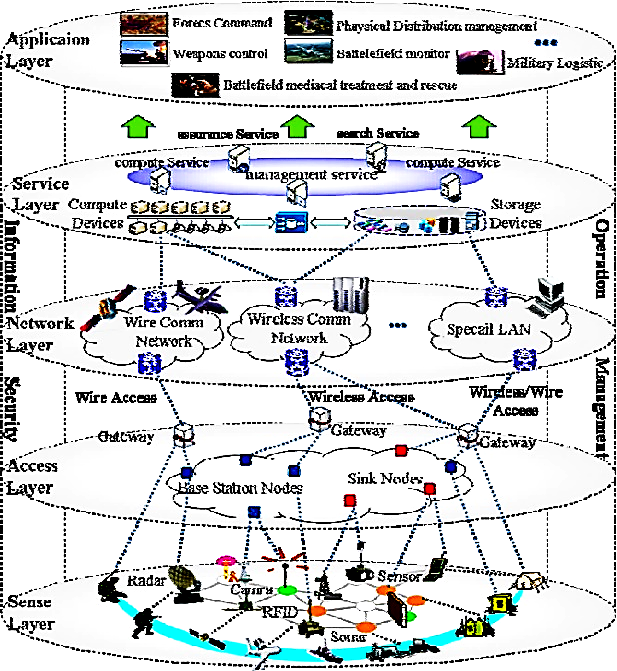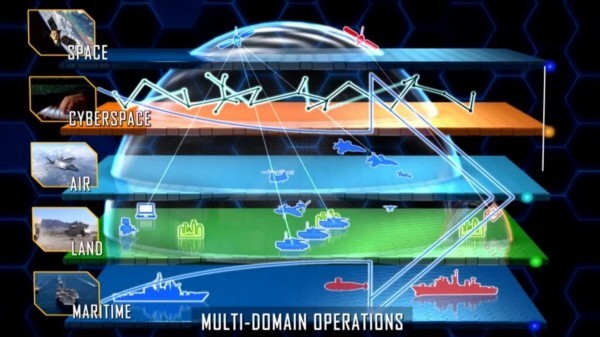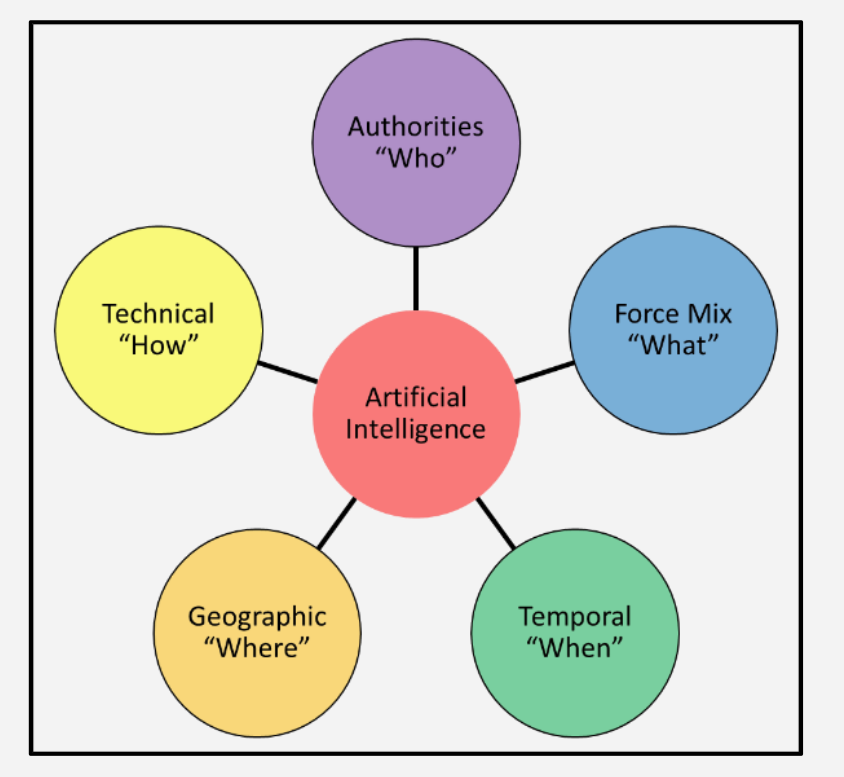
JADC2: Spearheading All-Domain Operations

Source:news.usni.org
Hypothetical Scenario (04 July 2028). A North Korean ICBM is launched from outside Pyongyang. 10 seconds into the launch, its heat ejecta is picked up by a US surveillance satellite. The Pentagon seeks inputs from Commander of US Forces Korea (USFK) and the US Indo-Pacific Command (INDOPACOM), who confirm the launch. The ICBM is heading past earths’ atmosphere as Pentagon attempts to analyse whether the target is a surface asset or a US/friendly satellite. The responsibility of tracking the missile’s flight profile and initiating anti-missile procedures on the US Mainland/ proximal island territories devolves to Commander US Strategic Command (STRATCOM). The ICBM reaches its apogee and starts to manoeuvre towards re-entry, thus confirming that the target is a surface asset/location. The responsibility of carrying out counter-missile preparations once again falls back to Commander INDOPACOM. The ICBM then overflies Guam and is headed for the West Coast of the US. The onus of tracking the missile and carrying put counter manouevres immediately shifts to North American Aerospace Defense Command (NORAD) and US Northern Command (NORTHCOM), responsible for protection of the skies and territory of the US Mainland.
-Adapted from a talk by General David Goldfein, CSAF & duly modified
The above changes in responsibility have taken place over a time-span of 30 minutes from launch, thus establishing the severely shrunken Observe-Orient-Decide-Act (OODA) time available to the Commanders. The scenario also demonstrates the high dependence such fast moving operations place on robust and seamless communications and automated information processing. It may worry some of us that the communications and information processing architecture of today’s Armed Forces may not be adequate to meet such shrunken OODA cycles, as would also be the present concepts of warfighting in isolated, domain specific ‘conflict bubbles’. This brings to the fore the importance of capability building for multi-domain(MD) operations (MDO).
How Does The Archetypal Joint Warfare Differ from All Domain Jointness?
[All-Domain Operations combine] “space, cyber, deterrent, transportation, electromagnetic spectrum operations, missile defense — all of these global capabilities together … to compete with a global competitor and at all levels of conflict.”
-Gen John Hyten, Vice Chairman, Joint Chiefs of Staff, US
Present efforts at jointness as part of Joint Warfare involve intelligence sharing and joint decision making at best, with targeting orders being supplied through the principal operating Service in a particular domain, be it land, sea, air or cyber, in order to achieve results. Thus, in effect, while inputs were joint, tasking was mostly within the Service responsible for a domain. True jointness, therefore, continued to elude the Armed Forces of the world until now- when the concept of ‘all domain jointness’ allowing seamless information flow and tasking across Services and domains is being defined, with the US taking the lead in this paradigm.
China’s Anti-Access, Area-Denial (A2AD) Strategy presently builds MD capability across the PLA’s Armed Forces to deny physical/ electronic access into Chinese systems/territory by means of networked sensors/weapon systems linked through robust communication architecture- this has in effect catalysed US focus towards all-domain operations.
What is JADC2?
In a fast paced era of disruptive technologies, asymmetric capabilities and hybrid warfare, the OODA time available to military planners continues to shrink abysmally. There is therefore an imperative and urgent requirement to exponentially reduce ‘cause and effect’ gaps. This brings to the fore the need to focus on digital era ‘shielded’ communications, machine processing, AI and data analysis at all levels in a conflict arena, in order to respond ‘fastest with the mostest’, thus crippling the adversary’s capabilities to prosecute pan-domain war. Such technologies are essential to collate dissimilar information in terms of ‘resolution’ and originators across the entire force structure and disseminate such actionable information across all warfighting domains, right from strategic platforms to frontline tactical entities.
The acronym JADC2 expands to ‘Joint All Domain Command & Control’ and encompasses all resources/efforts to ‘enmesh’ a Nation’s warfighting capabilities, transcending Services and land/sea/air/spectrum/cyber/space(!) domains to achieve a joint force objective. As is evident, the scope of such a concept is vast and brings with it challenges of connectivity, Intelligence, Surveillance & Reconnaissance (ISR) sharing, time sharing of resources, tasking and finally battle damage assessment.
The premise of JADC2 is to graduate from the hithertofore centralised concept of command and control to a more distributed one that connects every sensor to every shooter and blends AI with human judgment to accelerate decision making. “Ultimately, it’s about bringing the entire decision loop into the JADC2 architecture to stay ahead of the adversary, in terms of generation of information and military actions”.
The US JADC2 Program could be ascribed as a fallout of the US National Defense Strategy (NDS) of 2018. The Program is an initiative by the US Department of Defense (DoD) to revamp the current C2 architecture associated with the Armed Forces by putting in place measures that would enable MD, real-time decision making through an enmeshed network of sensors and platforms across the US Air Force/Army/Marine Corps/Navy/Space Force and across domains.
What Would Be the Pillars of JADC2?
General Joe Dunford, Ex Chairman Joint Chiefs of Staff (CJCS) purported the idea of global force management– a new perspective that looks across traditional jurisdictions of theatre commands. He added the concept of global fires and physical (kinetic weapons)/non-physical(cyber-attacks) means that could be launched from outside a theatre of operations to achieve effects within that theatre.
General Mark Milley, the present CJCS, added new elements to the concept of all domain warfare: global plans– not just planning for set scenarios but rapid crisis response; global operations short of fires–, operations in the so-called “grey zone” between peace and all-out war; global integration of messaging– deliberate use of words and actions to reassure allies and deter adversaries; and global integration of deterrence– use of the entire weapons spectrum to deter potential adversaries from undertaking misadventures inimical to National interests.
C2. For JADC2 to be effective, “any sensor should be able to link to any shooter and any C2 node- eg:- an Army C2 node/ forward entity with actionable targeting data should be able to task air/land/maritime platform(s) for engagement, based on suitability and economy of effort. This bottom-up approach (BUA) better suits the objective of delegated decision authority, thus facilitating faster decision-making. The apparent disadvantage is that the BUA might compromise efficiency or economy of effort in achieving desired effects due to a lack of insight of the coordinated battle at the strategic level. Therefore, a dynamic combination of bottom-up and top-down C2 would best suit JADC2, with decision of selection vested in strategic commanders. This dynamic approach would necessitate nomination of lead Service in every battle contingency, to execute C2 and prosecute operations.
Communication & Systems Architecture. Broad bandwidth and dynamic spectrum sharing with 5G technology would allow larger and faster data sharing upwards from battlefield sensors (human/digital) to decision makers and then onto engagement platforms, in near-real time without the hazards of slow data transfer or congestion on communication highways. The aspect of dynamic spectrum sharing available with 5G communication enables simultaneous use by multiple subscribers in a congested and contested EW environment. Apropos, the US DoD has proposed utilisation of 5G technology as one of the backbones of the JADC2 communication architecture.
A common definition of Internet of Things (IoT) would be a ‘system of interrelated computing devices or other objects/personalities that are provided with unique identities and have the ability to transfer data over a network without requiring human-to-human or human-to-computer interaction. As an extension, the Internet of Military Things (IoMT) is the application of IoT technologies to the military domain. The US Army further extends the IoMT concept to the Internet of Battlefield Things (IoBT), where a plethora of military entities, platforms and sensors are linked across the battlefield, exploiting autonomy and AI to provide frontline situational awareness to quickly generate apt engagement recommendations and thereby achieve mission objectives- a facet critical to JADC2, proviso that the security of this enmeshed network can be ensured.

Depiction of IoMT/IoBT: Source-semanticscholar.org
‘Mosaic Warfare’ & AI. As per the US Congressional Research Service (CRS) Report of 12 August, Mosaic Warfare (MW) represents a series of Defense Advanced Research Projects Agency (DARPA)-sponsored projects (a ‘system-of-systems’) utilising AI to combine systems and networks not otherwise designed to interoperate. Conceptually, MW would allow collection of raw intelligence from a sensor (eg:-satellite) and conversion of data into targetable information, passed to a ‘shooter’- a cyber/EW weapon, missile, aircraft, or any other suitable platform. MW would also enable AI-generated software to allow wireless systems to inter-communicate in real/near-real time. Another benefit of such inter-communication between different layers of operability would be air asset allocation and airspace management. Instead of relying on a manpower intensive ‘operations room’ to carry out these tasks, AI enabled MW software would automatically track, process and disseminate such information to decision making/ mission allocation authorities in a ‘hot’ (continuous updation) mode. A pre-requisite would of course be to ensure data authenticity and security, to completely obviate wrong inputs for decision making.

Depiction of MDO Driven by JADC2 and Enabled by MW: Source-modernbattlespace.com

Depiction of AI Enabled Decision Making: Source-CRS Report of 12 Aug 21
What are the Present Efforts towards JADC2 in the US Armed Forces?
DoD. In order to validate the JADC2 concept, DoD has chaired at least two major exercises. The first, held in December 2019, focused on a simulated cruise missile threat and was the first demonstration of the Advanced Battle Management System (ABMS) of the USAF. Various weapon platforms, ground sensors and commercial satellites demonstrated the ability to collate, process and disseminate data for real-time operational inputs. A second evaluation was carried out in July 2020, wherein aircraft of USAF were networked with US Navy assets, components of US Special Operations Command and other NATO assets located in the Black Sea in a simulated environment to counter an adversary threat.
Joint Staff. Under the DoD, the US Joint Staff is the lead agency for formulation of JADC2 doctrine & policies for the Joint Warfighting Concept, of which JADC2 is a vital component. The Joint Staff have nominated the USAF as the lead Service for JADC2 technology development.
USAF. The ABMS is a unified-domain C2 system that connects existing sensors/shooters and distributes collated information to all domains. The ABMS architecture has undergone preliminary ground tests, with the USAF carrying out multiple demonstrations connecting C2 systems across Services in 2020.
US Army. The US Army has identified modernization as the key enabler for MDO. Army Futures Command (AFC), established in 2018 and mandated with ensuring future-readiness of the US Army, is tasked with developing JADC2 enablers for the Army. As part of an exercise called Project Convergence, the AFC has conducted a series of experiments demonstrating the Army’s ability to provide its components access to multi-Service, MD networks.
US Navy. On 01 October 2020, the Navy announced commencement of Project Overmatch, aimed at establishing an integrated C2 network by linking maritime and shore assets with the other Services. The US Navy has stated that the initial focus of Project Overmatch would be to support carrier strike group operations with JADC2 characteristics. The ultimate goal would be to develop a new ‘Naval Operational Architecture’ using AI and manned/unmanned teaming (MUMT) (previously described in detail in an article @ChanakyaForum https://chanakyaforum.com/the-unmanned-wingman/ ) to enable Distributed Maritime Operations, which envisions localised control of dispersed maritime assets to increase survivability and enhance collective operational effectiveness.
Conclusion
The necessity and urgency of capability building for MD joint operations cannot be overemphasised in today’s volatile, uncertain, complex and ambiguous conflict environment, where Nations vie for control of economic fountainheads. While the US may be the lead Nation in implementing global JADC2, countries like India must presently strive forwards in this field to safeguard regional interests. However, for JADC2 to truly and wholly succeed, traditional impediments of inter Service rivalry/ ill-defined C2 relationships and shortfalls in communications and information processing capabilities will have to be speedily and effectively addressed.
*********************************************************************************************************
Disclaimer
The opinions expressed in this article are the author’s own and do not reflect the views of Chanakya Forum. All information provided in this article including timeliness, completeness, accuracy, suitability or validity of information referenced therein, is the sole responsibility of the author. www.chanakyaforum.com does not assume any responsibility for the same.
Chanakya Forum is now on . Click here to join our channel (@ChanakyaForum) and stay updated with the latest headlines and articles.
Important
We work round the clock to bring you the finest articles and updates from around the world. There is a team that works tirelessly to ensure that you have a seamless reading experience. But all this costs money. Please support us so that we keep doing what we do best. Happy Reading
Support Us





















POST COMMENTS (0)